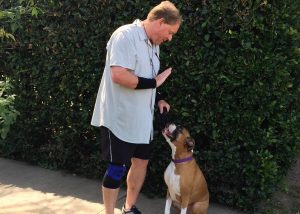
In our world of the internet, reality television, easy access information, and instant gratification, we like to fix our problems quickly and on our own. Medical websites help us diagnosis what is wrong with us without the doctor (or do they?), and many of us feel that the endless dog training websites will allow us to fix Fido too.
The problem with websites that give us a little knowledge is that we aren’t always knowledgeable enough to fix the problem. Doctors speak of patients that come in already knowing what is wrong (but they often are misdiagnosing themselves), and dog trainers see all the time the result of people watching TV shows and looking on-line for that quick fix method to try without results.
There is nothing wrong with doing research on a topic, and if you have a dog with aggression, reading all about it can give you a greater sense of what might be happening. Unfortunately, without the skills and knowledge base that comes from working with a lot of dogs, you might not be on target with your diagnosis of your dog.
What might go wrong if you do it yourself?
1. You might misidentify what is happening with your dog. Perhaps your dog is experiencing a lot of fear in a situation, and you don’t realize that is what is motivating his aggression. This could cause greater problems down the road if you’re not quite sure what is happening.
2. What method to use? There are many, many methods available, and there are a lot of competing voices that proclaim to be experts. It is hard to know what voice to follow. Anyone can call themselves a dog training expert.
3. Application of method: Even if you find a good plan of action via research, you’ve got to know how to apply it. Sometimes it’s not the plan that is hard but the learning how to apply it that is.
4. Quiting! Many people get frustrated with their aggressive dog and quit any method that doesn’t work right away. This can lead to switching from one method to another to another and following any piece of advice one hears. This is highly counter-productive.
5. It is possible to make the situation worse, believe it or not. Perhaps you hear that an alpha roll (where you take the dog and physically roll him over on his side) will help solve all obedience and aggression problems you have with your dog because your dog is only doing it out of dominance. Did you know many people are bitten trying this maneuver on their dog who becomes frightened and feels threatened by someone he trusts?
6. Not only can the situation be made worse, you can even create new problems! For example, a dog treated for aggression with heavy punishment can become anxious in future situations. Now you’re dealing with the aggression issue plus a newfound anxiety.
No easy fixes
It would be great if there were an easy fix for an aggressive dog, but unfortunately there just isn’t. You’re dealing with a behavioral issue that likely didn’t develop overnight, so it will take time to undo that learning. Aggression can become quickly ingrained, and many times to ‘fix’ what is wrong, you have to change a lot of things in the situation, not just the dog.
This is where a professional comes into play. This person is an objective, outside observer that can see what is going on more clearly. This person also has the skills and knowledge to develop a behavior modification plan that can work and help guide you through the process. That being said, not all professionals are created equal!
When looking for help, you should:
• Do your research. Ask your veterinarian and other pet resources for referrals and browse the internet. Look at the website for the Association of Pet Dog Trainers and other professional websites. See if there is a veterinary behaviorist located in your area.
• Once you have a list of names, view their websites. Give them a call. Ask about their qualifications as a dog trainer, how long they have been training dogs, how long they have been working with aggressive dogs specifically, and what their methods are for working with these dogs. You need to know where they stand before you invite them to help you. Many trainers will also allow you to visit their training facility or watch a training class. While not the same as working with an aggressive dog, it will give you a sense of how the trainer works with people and the dogs. This is important because communication between you and the trainer will be important.
• Run from any trainer that guarantees to fix any and all problems. This isn’t always possible.
When you find the right trainer to work with, the trainer will be invaluable to assisting you. The trainer should not only evaluate your situation and dog but be able to develop a plan to help modify his behavior and show you how to do it. This might include changing how family members interact with the dog, changing the equipment you use with the dog, and offering suggestions of medications that might be of value in your dog’s situation. The trainer also needs to be flexible enough to know that if the dog doesn’t appear to be responding to one method, the trainer has to be willing to come up with other solutions and keep you on track.
Final thoughts…
At the end of the day, aggression is not the same as teaching a dog to sit or lie down. Aggression can be scary and can lead to a family member or someone else being bitten. There is a high risk of liability assumed with an aggressive dog (ethical considerations, possibility of loss of insurance, possibility of being sued, removal and destruction of dog, etc). This is just one of those situations that is best left to a professional to help you and guide you through the process. You and your dog will have a far better outcome.
